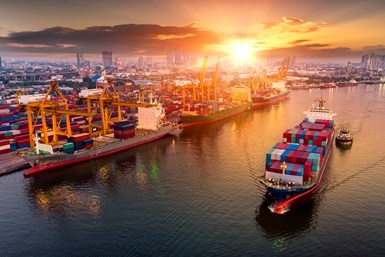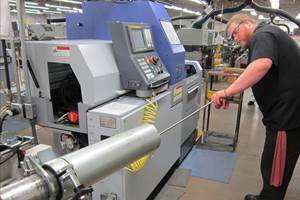Supply chain chaos has dominated headlines for the past year and remains a problem. As of April, the cost of shipping containers has increased by approximately 291% since the same time in 2021, according to Drewry’s composite World Container Index. Material shortages, loss of suppliers and altered shipping routes have left many manufacturers unable to produce. Inflation is making it harder to maintain profits, driving price increases even more, and The New York Times doesn’t expect a full return to normal any time in 2022.
With so much upheaval impacting manufacturers in every sector, industry leaders have one driving question: What can we do to stop this from happening again?
Here are five lessons we learned from the events of the past few years in order to find a solution for the coming decade:
- Localizing supply chains and diversifying suppliers is key. An overreliance on few international suppliers has made the global supply chain incredibly fragile to disruption. Now, many companies are building up supply chains with multiple vendors and locating closer to where their customers are, so sourcing, production and distribution can all occur in the same region. As a result, U.S. manufacturers are beginning to invest more heavily in countries such as Malaysia and Vietnam. This minimizes risk of disruption during shipping and reduces carbon emissions.
Other companies need to reshore or nearshore their production base to prevent impact from international disruptions. Many U.S. companies are also now expanding their presence to Central America. As more investment pours into manufacturing in these regions, this will create a more robust, decentralized supply chain that operates with more resilience.
- Carrier consolidation is unsustainable. Sourcing and labor are not the only parts of the supply chain that have consolidated over the past few decades — the channels through which materials and products move across the world have become more homogenous as well. Many ocean shipping companies have unified in three alliances that carry more than 80% of the world’s cargo. In the past, there were more than 40 rail companies that handled shipments over land. Now, that market has been culled to seven. Such consolidation can control costs, but it leaves shipments vulnerable to disruption.
- Just-in-time manufacturing is unreliable. “Just-in-time” manufacturing techniques have been the de facto way companies control inventory, maximize storage space and control overall operating costs. Previously, this was a win-win for both consumers and company shareholders, but as the COVID-19 pandemic showed, limited inventory availability creates problems if production unexpectedly ceases.
Many companies are now increasing their inventory capacity to make use of material as it's available — because it might not always be. The Financial Times refers to this phenomenon as a shift from “just-in-time” to “just-in-case” manufacturing.
- High-tech operations are essential. The ongoing labor shortage and skills gap has spurred investments in automation technology. During the COVID-19 lockdowns, with caps on how many workers could be on the floor at any given time, fully automated and collaborative machinery became essential. Other investments in cloud computing, artificial intelligence and building IOT need to happen sooner rather than later not only to join the Industry 4.0 revolution but to recover quickly from business losses due to the pandemic.
- Even small waste has major impact. With inflation, fluctuating material prices, supply shortages and shipping delays, it’s imperative to control costs in all manufacturing processes — down to the procedures followed on the shop floor in terms of equipment maintenance and even cutting fluid management. Increasingly, manufacturers are refining their coolant management protocols to maximize sump life, reduce downtime and maintain high performance.
Cutting fluid performance directly impacts everything within a manufacturing facility, from the people, to production, to machinery. Making the most of high-quality cutting fluid can translate to dramatic savings across an entire budget and even help generate more revenue.
Ensuring long sump life and top performance minimizes coolant order volume throughout the year, drastically cutting supply costs and minimizing waste. Well managed fluid also extends tool life, reducing tool costs as well as machine downtime. It provides higher lubricity and cooling ability, enabling operators to run faster feeds, increasing productivity and lowering cost per part. Coolant management even benefits workers by reducing odors and controlling bacteria and sources of potential dermatitis.
It’s unclear when supply chain chaos will die down and return to some semblance of normal. But it is clear that “normal” supply chains weren’t as safe and resilient as we thought. Building up local supply chains, diversifying suppliers, maintaining healthy inventory levels and investing in automation can all create a more resilient supply chain.
About the Author
David Barned serves Master Fluid Solutions as the senior VP and general manager of the North American Business Unit. He has worked with the company for almost 30 years, driving innovation and growth through roles that spanned marketing, supply chain management and operations.
Related Content
When a CNC Turn-Mill Doesn’t Turn
A shop in Big Sky Country uses a B-axis multitasking machine to produce complex, prismatic medical parts that require no turning complete from barstock.
Read MoreVideo: Why a Production Machine Shop Started a Baseball Bat Company
A 153-year-old manufacturer of precision, metal pins recently started a side business creating custom wooden baseball bats. The reasoning behind establishing this new company is intriguing, as is how it has helped create a stronger bond with the local community.
Read More6 Tips for Training on a Swiss-Type Lathe
There are nuances to training a person to effectively operate a Swiss-type lathe. A shop I visited a while back offers some suggestions.
Read MoreCNC Turning Tips for HRSA Materials
Rough-turning, heat-resistant superalloys can be challenging. However, new carbide insert technology provides the capability to perform high-speed, high-feed roughing in a single pass.
Read MoreRead Next
Supply Chain or Inflation? The Real Question
The precision machined products industry is working overtime and outperforming the rest of the industry to ensure that people have the parts they need.
Read MoreSupply Chain Management Can Work for You
A VMI program can reduce cost and also increase speed to market by eliminating the additional time needed to move material from vendor to vendor.
Read MoreA Tooling Workshop Worth a Visit
Marubeni Citizen-Cincom’s tooling and accessory workshop offers a chance to learn more about ancillary devices that can boost machining efficiency and capability.
Read More










.jpg;maxWidth=300;quality=90)













